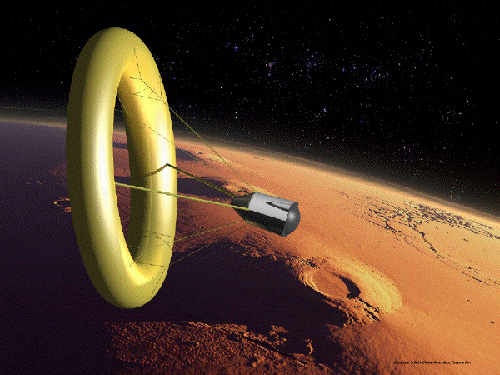| FOR IMMEDIATE RELEASE
April 15, 2009
Contact: Kristin Medlock (626-345-1200)

ALTADENA, CA – Global Aerospace Corporation announced today that it has begun development of a Hypersonic Control Modeling and Simulation Tool (HyperCMST). HyperCMST will be used for control studies for planetary atmospheric entry and descent, aerodynamic orbital capture, and aerodynamic gravity assist. This new tool will allow engineers to model and simulate optimal control trajectories for a variety of hypersonic vehicles and has direct applications to NASA Exploration missions to the Moon, Mars, and Earth-return in addition to robotic space science missions to planets and satellites that have substantial atmospheres.
Funded by the NASA Small Business Innovation Research (SBIR) program, the Phase I proof-of-concept tool will focus on control of a unique type of hypersonic system called a ballute (BALLoon-parachUTE). A ballute is a large, inflatable device that takes advantage of atmospheric drag to decelerate and capture a spacecraft into orbit around a planet.
The tool development will initially focus on a new type of ballute called a lifting-towed-toroidal-ballute for use in orbit capture or entry scenarios. Figure 1 illustrates the beginning of a ballute-assisted orbit capture, or aerocapture, of a notional lander vehicle above the surface of Mars. This figure displays a toroidal ballute and inflation tubes connected to a Mars lander spacecraft via multiple control lines or tethers. Because the ballute is not rigidly attached to the spacecraft but, instead, attached via tethers behind the spacecraft, relative to the flight direction, it is considered “towed”. The ballute’s position behind the spacecraft is a result of the large drag force on the ballute. The ballute is jettisoned from the spacecraft once the desired capture orbit is achieved. Most current ballute concepts consider the ballute to be a drag-only device with no steerability. However, by manipulating the tether lengths between the spacecraft and the ballute, aerodynamic lift is created and control of the ballute system is possible. Lift control will enable the use of smaller ballutes for planetary orbit capture, by allowing the spacecraft to fly a longer path through the atmosphere to achieve more drag deceleration for a smaller ballute. The use of smaller ballutes will make them more attractive and feasible for missions to planets such as Neptune, where high heating rates require extremely large ballutes for drag-only capture. Ballutes can also be used to decelerate large payloads for landing at Mars. In this case, lifting ballutes can significantly reduce deceleration forces, which can result in lower mass ballute systems and reduced g-loads on crews that fly them to the surface of Mars.
In later development efforts, a comprehensive tool will be developed that extends its capability to other vehicles such as blunt body aeroshells (e.g. Mars Pathfinder), lifting body aeroshells, and waveriders, which are a new type of hypersonic vehicles that produce lift from their own shock waves.

Figure 1.
This is a computer-generated image of a lifting-towed-ballute performing aerocapture of a notional Mars lander above a ridge of volcanoes on Mars. The direction of flight is from left to right. The background image of the Tharsis Ridge of Mars was created by artist Kees Veenenbos, with permission, using data courtesy of NASA’s Mars Orbiter Laser Altimeter Science Team.
|

